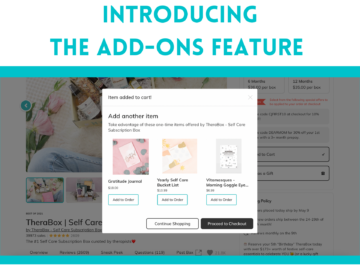By Mark Wilson
Getting your products to customers can be complicated enough, but when you throw liquids into the mix, it gets even trickier. So how can you ensure that any liquids you ship – whether you run a beauty box or cocktail kit – arrive safely?
There’s a lot to consider when preparing for fulfillment, from proper packaging procedures to specific laws that vary by region if you want to transport liquid goods.
With our tips, you’ll be shipping liquid products in your subscription box with ease. In this article, we’ll discuss:
- What’s considered a liquid
- How to securely pack your liquids
- When you need professional packing help
- How to label the outside of packages
- Rules for shipping hazardous liquids
- Rules for shipping alcohol
- How to manage shipping expenses
What’s Considered a Liquid?

Let’s get technical. It’s important to understand exactly what the shipping carrier you’ve chosen considers a liquid before shipping your items.
When shipping through the United States Postal Service (USPS), a liquid is classified as any sort of substance that flows effortlessly in the container that it is in.
This includes products you might not typically think of as “liquid,” like beauty creams or gels that have the potential to turn liquid under heat. (Keep in mind that mail trucks are made of metal and summer’s almost here!)
Know How to Securely Pack Your Liquids
When shipping liquids, carriers like the USPS have requirements intended to prevent damage to your items as well as other mail and postal equipment. For example, general packaging requirements ask that customers use containers that resemble the screw-cap ring found on unopened soda bottles.
In other words, you should use a screw cap that can twist open and closed. The cap should be attached to a circular “retaining” ring on the lip of the bottle.
You can find both items online at Amazon or at hardware stores like Home Depot. For liquids shipped in breakable containers like glass, it’s important to place the entire item within a closeable bag as well.
Once you place the bottle securely in the bag, use cushioning materials into the bag like newspaper, bubble wrap or packing peanuts to wrap around the container and keep it safe. Then you can close the outer bag.
Securely containing your product isn’t just about product protection. Find out why packaging inserts can raise your ROI.
When you select your packaging, keep in mind that shipping liquids in plastic containers can be a huge risk, as plastic can easily be damaged in transit and cause the liquid inside to leak.
When Do You Need Professional Packing Help?

If you know that you’ll have a large volume of liquids to ship, consider joining the International Safe Transit Association.
ISTA is a nonprofit association that aims to make sure your products get from point A to point B safely. It does this by running a package through various simulations of environmental hazards and measuring how well the package survives these conditions.
They can then help you pick the right shipping solutions that meet your company’s demands and budget.
To start, sign up as a member of ISTA online. Once your membership is approved and your items have been tested through their screening system, ISTA will provide your packages with visible certification marks that show it meets all necessary criteria for shipment with your chosen carrier.
Know How to Label the Outside of Packages
In addition to sealing liquids in the right internal and external packaging, it’s important to alert the carrier to the contents of the box!
Mark the outside of your package as containing liquids so that the postal staff can properly handle it from pickup to delivery. On the top and side of the shipping container, write “LIQUID” and “FRAGILE” to clearly and quickly convey the package’s contents. You might also consider printing labels or stamps with these terms if you ship liquids frequently.
Interested in custom labels or stamps? Check out our overview here.
Rules for Shipping Hazardous Liquids
Of course, even with the best packing materials, some liquids come with tougher shipping restrictions.
Products that contain flammable liquids, such as cigarette lighters, cannot be sent via airmail or internationally through USPS but can be shipped via ground mail. (Remember that inflammable also means flammable; that quirk of language can trip us up sometimes, too.)
Liquid corrosives, such as some batteries and hydrofluoric acid, can be shipped domestically as long as the mixture is 15% or less corrosive material.
If you ship this type of product by air, on the other hand, you must declare it as a dangerous good. If you’re not sure a liquid classifies for shipping, contact the shipping representative of your chosen carrier.
Rules for Shipping Alcohol

The reason alcohol carries its own shipping restrictions dates back to Prohibition, when it was banned under the 18th Amendment.
When the 21st Amendment reversed that ruling, it also gave states the power to enact their own laws concerning the production, distribution, and sale of alcohol.
Shipping alcohol via USPS is banned, both domestically and internationally, for any beverages containing half an ounce or more of alcoholic content.
It’s also important to note that USPS can reject shipments packaged in containers that were once used to transport alcohol and have the branding visible.
Your safest bet when it comes to shipping alcohol is to use a carrier like UPS or FedEx. For both carriers, you must follow certain protocols such as having an account number, an alcohol shipping agreement in place, and documentation that lists the shipment as alcoholic.
You must have the packages clearly labeled according to UPS or FedEx guidelines. Alcohol shipments require an adult signature at delivery and must be signed for by someone over 21 years of age.
When it comes to packing your alcohol in a custom shipping box, each bottle must be placed securely in the center of a sturdy container and away from the side walls.
Confused or have questions? Find your local UPS or FedEx location on their websites.
Shipping experts are on hand to guide you and help ensure that your alcoholic items arrive safely to their destinations.
Know How to Financially Manage Shipping Expenses
As a subscription box owner, you already know that shipping can cause financial woes. Following our best practices can help address these operating stresses.
One method is to ask your carrier’s small business specialist to compare the shipping cost by ground versus air.
Another best practice is to purchase a postage meter to weigh each package at your business. This lets you assess for yourself the exact shipping charge, effectively eliminating excess postage fees. This only applies if you are printing your own shipping label and using a pick-up service from your carrier.
Read more: Our ebook on shipping and billing can answer more questions, including how to structure your shipping cycle.
Ready to Get Your Feet Wet?
When shipping liquids, taking the time to properly package them in your subscription box will avoid costly mistakes. After all, you don’t want your customers to feel like wet blankets when they receive your product.

Mark Wilson is a creative writer at Packlane, an online printing company that makes the process of ordering custom boxes and packaging easy and affordable for brands of any size. Packlane offers low minimums, fast turnaround, full customization options, and free online proofs in 3D.



